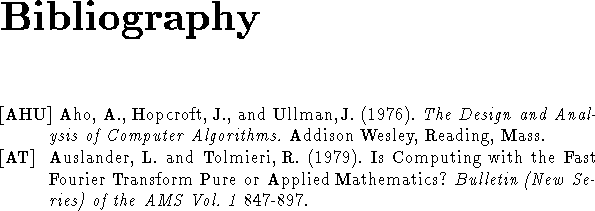
It's easiest just to give an example:
\begin{thebibliography}{[AHU]}
\bibitem[AHU]{ahu} Aho, A.,\ Hopcroft, J.,\ and
Ullman, J.\ (1976). {\em{The Design and
Analysis of Computer Algorithms.}} Addison
Wesley, Reading, Mass.
\bibitem[AT]{AT} Auslander, L. and Tolmieri, R.
(1979). Is Computing with the Fast Fourier
Transform Pure or Applied Mathematics?
{\em{Bulletin (New Series) of the AMS Vol. 1}}
847-897.
\end{thebibliography}
yields

We have first specified the largest bibliographic label
with ({AHU}),and then
specified that the bibliography entries are to be
labelled [AHU] and [AT]. If you prefer a
numbered bibliography, you can leave out the bracketed argument.
(The commands here would then begin \bibitem{ahu} Aho,... and
\bibitem{at} Auslander,....) In that case, ![]() would number
the bibliography entries automatically. Also, there is a
command
would number
the bibliography entries automatically. Also, there is a
command \cite{ } for making references in the text to a
bibliography item which works a lot like \ref{ }
(described above). You can type \cite{key} where
key appears in curly braces to a
\bibitem command; ![]() will then insert the correct
reference number in brackets.
For example, if we had let
will then insert the correct
reference number in brackets.
For example, if we had let ![]() number the bibliography above,
we could type
number the bibliography above,
we could type
It was proved in \cite{ahu}, ...
to produce ``It was proved in [AHU], ...''.